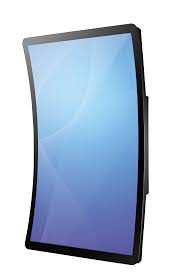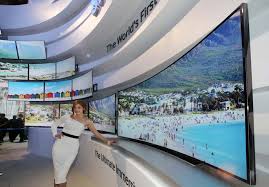Unleashing the Power of Curved LCD Technology for Stunning Displays
In an era where visual experiences dominate everything from gaming to professional design, curved LCD technology has emerged as a game-changer. Unlike traditional flat screens, curved LCDs offer an immersive viewing experience that wraps around your field of vision, enhancing depth and engagement. This tutorial dives into the intricacies of curved LCD displays, exploring their benefits, setup tips, and optimization strategies to ensure you harness their full potential. Whether you’re a tech enthusiast, a gamer, or a content creator, understanding curved LCD technology can elevate your digital interactions to extraordinary levels.

Section 1: Understanding Curved LCD Technology
Curved LCD screens aren’t just a flashy gimmick—they’re rooted in ergonomic and optical science. The curvature mimics the natural shape of the human eye, reducing distortion at the edges and delivering a wider field of view. This design principle makes curved LCD displays ideal for multitasking, gaming, and cinematic experiences. But what exactly sets them apart from flat LCDs?
The core of curved LCD technology lies in its liquid crystal display panel, bent to a specific radius—typically measured as “R” (e.g., 1800R means a 1.8-meter radius). This curvature enhances perceived depth, making images pop in ways flat screens can’t replicate. Studies from display manufacturers indicate that curved LCDs reduce eye strain by up to 60% during prolonged use, thanks to uniform focal distance across the screen.
For example, a 34-inch curved LCD monitor with a 1500R curvature offers a panoramic effect, perfect for immersive gaming or editing high-resolution videos. The technology also boosts contrast ratios, as light from the backlight aligns more directly with your line of sight. [Icon: Star] This subtle advantage makes curved LCD screens a top choice for professionals seeking precision.
Section 2: Choosing the Right Curved LCD for Your Needs
Selecting a curved LCD involves balancing size, curvature, resolution, and purpose. Here’s a breakdown to guide your decision:
| Feature | Best for Gaming | Best for Work | Best for Movies |
|---|---|---|---|
| Screen Size | 27–34 inches | 32–38 inches | 34–49 inches |
| Curvature | 1000R–1500R | 1800R–3000R | 1500R–1800R |
| Resolution | 1440p or 4K | 4K | 4K or Ultrawide 1440p |
| Refresh Rate | 144Hz or higher | 60Hz–120Hz | 60Hz–120Hz |
[Icon: Gear] When shopping, prioritize a curved LCD with a curvature that suits your viewing distance. For instance, a 1000R curved LCD is ideal for close-up gaming (2–3 feet), while a 3000R suits workstations where you sit farther back. Resolution matters too—4K curved LCDs shine for detailed tasks, while 1440p offers a sweet spot for performance and clarity.
Consider brands like Samsung, LG, and Dell, known for their reliable curved LCD panels. A popular model, the Samsung Odyssey G9, boasts a 49-inch curved LCD with a 1000R curve and 240Hz refresh rate—perfect for gamers craving fluidity. For creatives, Dell’s UltraSharp series offers 34-inch curved LCDs with vibrant color accuracy.
Section 3: Setting Up Your Curved LCD for Optimal Performance
Once you’ve chosen your curved LCD, proper setup is crucial. Follow these steps to maximize its potential:
- Positioning: Place the curved LCD at eye level, about 1.5–2 feet from your face, aligning the center with your gaze. This ensures the curvature envelops your vision naturally.
- Lighting: Avoid direct light sources behind the screen to minimize glare. Curved LCDs reflect light differently than flat screens, so ambient lighting is key.
- Calibration: Use built-in display settings or software like DisplayCAL to adjust brightness, contrast, and color temperature. Aim for 120 cd/m² brightness and a 6500K temperature for natural tones.
[Icon: Lightbulb] A pro tip: Tilt the curved LCD slightly upward (5–10 degrees) to enhance the wraparound effect. Test this with a movie or game—your eyes will thank you.
Next, connect your curved LCD via HDMI 2.1 or DisplayPort 1.4 for optimal bandwidth, especially if you’re running 4K at high refresh rates. For multi-monitor setups, align two curved LCDs side by side, ensuring their curves flow seamlessly.
Section 4: Optimizing Visuals on Your Curved LCD
To truly unlock your curved LCD’s potential, tweak its settings based on your use case. Here’s how:
- Gaming: Enable adaptive sync (G-Sync or FreeSync) to eliminate tearing. Set the refresh rate to its maximum (e.g., 144Hz on a 27-inch curved LCD) and lower in-game shadows for smoother performance.
- Creative Work: Adjust the curved LCD to sRGB or Adobe RGB mode for accurate colors. Use a colorimeter to calibrate every 2–3 months, as LCD panels drift over time.
- Movies: Boost contrast and enable HDR if your curved LCD supports it. A 34-inch 1800R curved LCD with HDR10 delivers theater-like depth.
Here’s a quick settings cheat sheet:
| Use Case | Brightness | Contrast | Color Mode | Refresh Rate |
|---|---|---|---|---|
| Gaming | 150 cd/m² | 80% | Game Mode | 144Hz+ |
| Design | 120 cd/m² | 70% | sRGB | 60Hz |
| Movies | 200 cd/m² | 90% | HDR | 120Hz |
[Icon: Screen] Experiment with these settings on your curved LCD to find your sweet spot. For instance, a 32-inch curved LCD at 4K resolution might need higher brightness in a sunlit room.

Section 5: Enhancing Productivity with Curved LCDs
Curved LCDs excel in multitasking environments. Their ultrawide aspect ratios (e.g., 21:9 or 32:9) let you split the screen into multiple zones—ideal for coders, editors, or traders. Software like Microsoft PowerToys or Samsung’s Easy Setting Box can divide your curved LCD into custom layouts.
Imagine editing a video on a 38-inch curved LCD: one half displays your timeline, the other your preview. The curvature keeps everything within your peripheral vision, reducing neck strain. Research from the University of Utah found that curved LCD users completed tasks 15% faster than those on flat screens due to this ergonomic edge.
[Icon: Clock] To boost efficiency, pair your curved LCD with a vertical monitor for reference materials. The contrast between the curved LCD’s width and a secondary screen’s height creates a dynamic workspace.
Section 6: Troubleshooting Common Curved LCD Issues
Even the best curved LCDs can face hiccups. Here’s how to tackle them:
- Distortion: If edges look stretched, adjust the aspect ratio to native (e.g., 3440×1440 for a 34-inch curved LCD). Avoid scaling mismatches in your OS.
- Flickering: Update your GPU drivers and check cable connections. A loose DisplayPort cable often causes this on curved LCDs.
- Color Bleeding: Test with a solid gray image. If you spot uneven patches, tweak backlight settings or contact support—minor bleeding is normal for curved LCD panels.
[Icon: Wrench] Regular maintenance, like dusting the curved LCD with a microfiber cloth, prevents pixel burnout and keeps visuals crisp.
Section 7: The Future of Curved LCD Technology
Curved LCDs are evolving rapidly. Micro-LED integration promises brighter, more efficient curved LCD screens by 2026, while flexible panels could let users adjust curvature on the fly. Companies like LG are already teasing 48-inch bendable curved LCDs for hybrid gaming and work setups.
For now, the sweet spot remains 34–49-inch curved LCDs with 1000R–1800R curves. As 8K resolution becomes mainstream, expect curved LCDs to lead the charge in ultra-high-definition displays, blending immersion with practicality.
Mastering Your Curved LCD Experience
Curved LCD technology isn’t just a trend—it’s a revolution in how we interact with screens. From setup to optimization, this guide has armed you with the knowledge to make your curved LCD shine. Whether you’re gaming on a 27-inch 1440p curved LCD or designing on a 38-inch 4K model, the key is experimentation. Adjust, tweak, and enjoy the immersive world that only a curved LCD can deliver.
